2022 Water and Wastewater Rate Study
Executive Summary
The City hired consultants NewGen Strategies and Solutions in 2020 to review the water utility’s cost-of-service. This work helps determine the rates and rate structure across all customer classes needed to equitably fund the water utility for the next five years, including all costs associated with operating, maintaining, and expanding the utility.
After examining the utility’s growth (Georgetown Water averages 5,000 new connections each year); the accelerated capital improvement projects (including the $175 million South Lake Water Treatment Plant that broke ground in May); and the increasing costs of inflation and interest rates, the City will need to raise customer rates for water and wastewater to ensure we have enough revenue to cover the costs of operating the utility and to meet our regulatory targets and requirements.
The new water and wastewater rates will go into effect Oct. 1, 2022. City Council considered the new rates through the budget adoption process July through September 2022.
On this page, we have provided more information about the cost-of-service study, rate comparison tables, presentations, documents, a timeline, answers to frequently asked questions, and a brief history of water rates in Georgetown.
The 2022 Water and Wastewater Rates Study included a five-year forecast for Georgetown’s water and wastewater services to identify what funding needs would be and what each customer class should be paying given their use of the system. Water and wastewater rates are projected to increase each year. In 2023, the rate increase is 13 percent across all customer types.
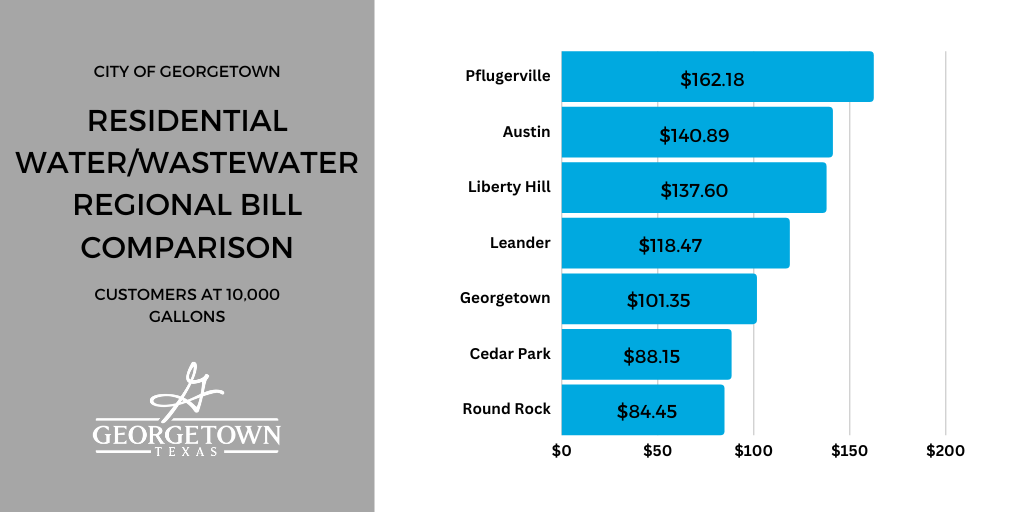 The new water and wastewater rates will go into effect Oct. 1, 2023. City Council adopted the new rates at its Sept. 12 meeting.
The new water and wastewater rates will go into effect Oct. 1, 2023. City Council adopted the new rates at its Sept. 12 meeting.
For water customers using 10,000 gallons a month, the monthly cost increase is $6.50. The average wastewater residential customer will also see a $5.50 increase each month.
The new rates do not cover the new Groundwater Reservation Agreement. Additional rate recommendations are expected in early 2024.
Timeline:
Aug. 22, 2023: City Council approves first reading of new water/wastewater rates. Agenda (Items 1.C, 6.N, and 6.0) | Workshop video and Regular meeting video
Sept. 12, 2023: City Council adopts new water/wastewater rates. Agenda (Items 5.AE and 5.AF) | Regular meeting video
Base Water Rates
| Base water rates: Inside City Limits *Rates take effect Oct. 1, 2023 *Cost is per 1,000 gallons |
||
| Size | 10/1/2022 | 10/1/2023 |
| 5/8 inch meter | $18.40 | $20.60 |
| 3/4 inch meter | $27.30 | $30.85 |
| 1 inch meter | $45.70 | $51.45 |
| 1 1/2 inch meter | $90.80 | $102.80 |
| 2 inch meter | $182.20 | $205.70 |
| 3 inch meter | $436.80 | $493.60 |
| 4 inch meter | $764.40 | $863.80 |
| 6 inch meter | $1,673.60 | $1,892.10 |
| 8 inch meter | $2,908.05 | $3,290.70 |
| Base water rates: Outside City Limits *Rates take effect Oct. 1, 2023 *Cost is per 1,000 gallons |
||
| Size | 10/1/2022 | 10/1/2023 |
| 5/8 inch meter | $22.10 | $24.75 |
| 3/4 inch meter | $32.85 | $37.10 |
| 1 inch meter | $54.90 | $61.85 |
| 1 1/2 inch meter | $109.20 | $123.65 |
| 2 inch meter | $219.00 | $247.35 |
| 3 inch meter | $525.10 | $593.60 |
| 4 inch meter | $918.90 | $1,038.80 |
| 6 inch meter | $2,012.00 | $2,275.45 |
| 8 inch meter | $3,496.00 | $3,957.35 |
| Volumetric Charge *Rates take effect Oct. 1, 2023 *Cost is per 1,000 gallons |
||
| Gallons | Current | Adopted |
| 0-7,000 | $2.05 | $2.30 |
| 7,001-15,000 | $3.10 | $3.45 |
| 15,001-25,000 | $5.35 | $6.05 |
| 25,000 and more | $9.40 | $10.60 |
| Non-Residential Volumetric Water Rates *Rates take effect Oct. 1, 2023 *Cost is per 1,000 gallons |
||||||
| Customer Type | Meter Size | October 1, 2022: Tier 1 Rate | 10/1/2023: Tier 1 Rate | October 1, 2022: Tier 2 Rate | 10/1/2023: Tier 2 Rate | Tier 2 Threshold |
| Small Commercial | <2″ | $2.70 | $3.05 | $7.25 | $8.20 | 300,001 gallons |
| Large Commercial | 2″ | $2.70 | $3.05 | $7.25 | $8.20 | 600,001 gallons |
| Large Commercial | 3″ | $2.70 | $3.05 | $7.25 | $8.20 | 900,001 gallons |
| Large Commercial | 4″ | $2.70 | $3.05 | $7.25 | $8.20 | 4,000,001 gallons |
| Large Commercial | 6″ | $2.70 | $3.05 | $7.25 | $8.20 | 6,000,001 gallons |
| Large Commercial | 8″ | $2.70 | $3.05 | $7.25 | $8.20 | 8,000,001 gallons |
| Manufacturing | <8″ | $2.70 | $3.05 | |||
| Municipal Interruptible | $2.70 | $3.05 | ||||
| Restaurant | $2.70 | $3.05 | ||||
| Evaporative Cooling | $2.70 | $3.05 | ||||
| Fire Flow | $2.70 | $3.05 | ||||
| Irrigation Only | $4.45 | $5.05 | $10.80 | 500,001 gallons | ||
| Fire Hydrant Meter | $9.50 | $10.75 | ||||
| Non-Potable Rates *Rates take effect Oct. 1, 2023 *Cost is per 1,000 gallons |
||
| Current | Adopted | |
| Reclaimed Water | $1.40 | $1.60 |
| Multifamily (Master Metered) Water Rates *Rates take effect Oct. 1, 2023 *Cost is per 1,000 gallons |
||||
| Inside October 1, 2022* | Inside October 1, 2023* | Outside October 1, 2022* | Outside October 1, 2023* | |
| Base | $18.40 x Unit Count | $20.60 x Unit Count | $22.10 x Unit Count | $24.75 x Unit Count |
| Tier 1 Unit Count x 7,000 gallons | $2.05 | $2.30 | ||
| Tier 2 Unit Count x 8,000 above Tier 1 | $3.10 | $3.45 | ||
| Tier 3 Unit Count x 10,000 above Tier 2 | $5.35 | $6.05 | ||
| Tier 4 all flows above Tier 3 | $9.40 | $10.60 | ||
| RV (Master Metered with oversized meter for fire flow) Water Rates 8 spots = one 3/4″ Single Family Unit *Rates take effect Oct. 1, 2023 *Cost is per 1,000 gallons |
||
| Inside October 1, 2023* | Outside October 1, 2023* | |
| Base | $30.85 x Unit Count/8 units | $37.10 x Unit Count/8 units |
| Tier 1 Unit Count x 7,000 gallons | $2.05 | $2.30 |
| Tier 2 Unit Count x 8,000 above Tier 1 | $3.10 | $3.45 |
| Tier 3 Unit Count x 10,000 above Tier 2 | $5.35 | $6.05 |
| Tier 4 all flows above Tier 3 | $9.40 | $10.60 |
Wastewater Rates
| Wastewater Rates: Inside City limits *Rates take effect Oct. 1, 2023 *Cost is per 1,000 gallons |
||||
| Customer Type | October 1, 2022*: Base | October 1, 2023*: Base | October 1, 2022*: Volumetric | October 1, 2023*: Volumetric |
| Residential | $38.85 | $43.90 | ||
| Commercial | $58.75 | $66.40 | $3.35 | $3.80 |
| High Strength | $52.70 | $59.55 | $4.90 | $5.55 |
| Large Commercial | $104.35 | $117.90 | $3.35 | $3.80 |
| Industrial | $81.05 | $91.60 | $3.35 | $3.80 |
| Large Industrial | $126.65 | $143.10 | $3.35 | $3.80 |
| Multifamily | $25.90 x Unit Count | $29.30 | ||
| Wastewater Rates: Outside City limits *Rates take effect Oct. 1, 2023 *Cost is per 1,000 gallons |
||||
| Customer Type | October 1, 2022*: Base | October 1, 2023*: Base | October 1, 2022*: Volumetric | October 1, 2023*: Volumetric |
| Residential | $44.70 | $50.50 | ||
| Commercial | $67.60 | $76.40 | $3.85 | $4.35 |
| High Strength | $60.65 | $68.55 | $5.65 | $6.40 |
| Large Commercial | $120.05 | $135.65 | $3.85 | $4.35 |
| Industrial | $89.90 | $101.60 | $3.85 | $4.35 |
| Large Industrial | $142.30 | $160.80 | $3.85 | $4.35 |
| Multifamily | $29.80 | $33.65 | ||
The study also identified that even under the recently adopted rates, the utility would not collect enough revenue to pay for the cost of operations including long-term capital projects as early as this year. City Council approved a midyear budget amendment in summer 2022 to cover increasing costs of chemicals, fuel, electricity, and other unavoidable costs.
The primary reasons for the needed increase in revenue are:
-
- Increased operation and maintenance costs associated with inflation (see table below)
- Interest rates
- Resiliency improvements
- Existing plant rehabilitations and debt service for the accelerated capital improvement projects
- Growth
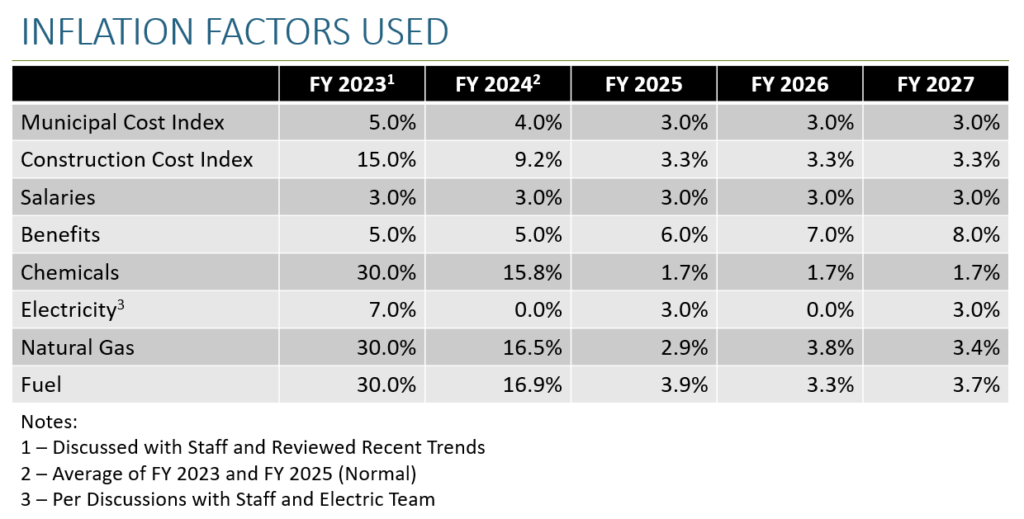
On June 9, NewGen presented proposed rate changes to the Water Utility Board. The adopted increases, which were approved City Council for Sept. 13, were as follows:
- Increase water and wastewater rates by 11.5 percent for both the base rate and tiered rates for all customer classes each year for the next four years (Oct. 1, 2022, through Sept. 30, 2026).
- Increase water and wastewater rates for all customer classes by 6 percent in 2027.
- As proposed, average residential customers using 6,000 gallons of water a month would see their monthly water and wastewater bill increase by $8 in the first year (from a total of $70.45 to $78.45 starting Oct. 1). The same customer would see their monthly water and wastewater bill increase by $44.80 through the final year (from a total of $70.45 this year to $115.25 in 2027).
- Increases for future years beyond 2023 are estimated at 11.5 percent for both base and tier rates; however, the City will conduct an impact fee study and subsequent rate study update in coming years to determine if the estimated future rates are correct.
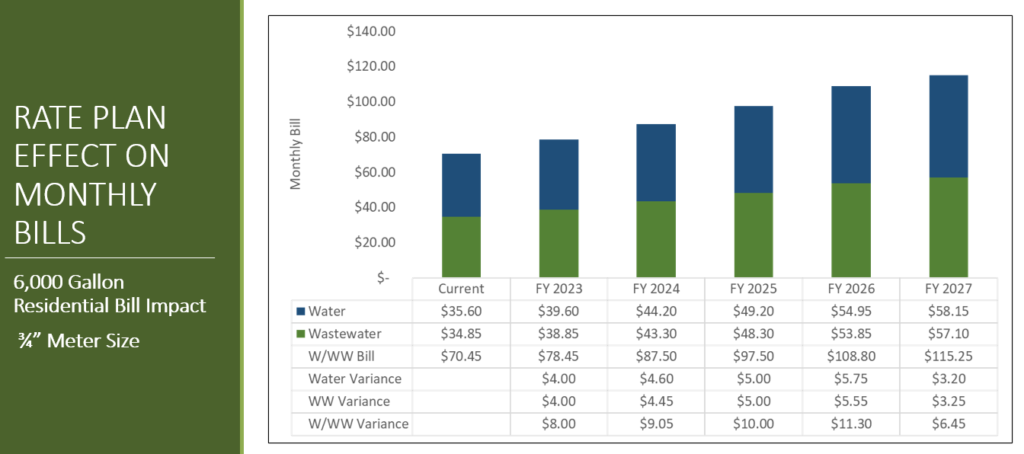
NewGen also found the City’s current rates are charging apartment complexes disproportionately to other residential uses. Instead of charging their water use per unit, our current rates charge them as a commercial property.
The adopted rates include modifying the rate structure such that apartment charges more closely resemble residential users. Although an apartment resident does not have the yard and discretionary capabilities that a residential customer does, the indoor usage is the same. For that reason, apartment water usage per unit is estimated to be about 70 percent the water usage of a single-family home.
Under the previous rates, a single-family home pays about $175 a year, while the cost for the same shower in an apartment unit is currently about $65. The adopted rate-structure change for multifamily aligns the costs for showers for an apartment unit to about $130 annually, which is about 70 percent of the single-family cost.
This change to ensure equity in our charges is expected to generate nearly $1 million in additional revenue, lowering the overall increase needed across all our customers.
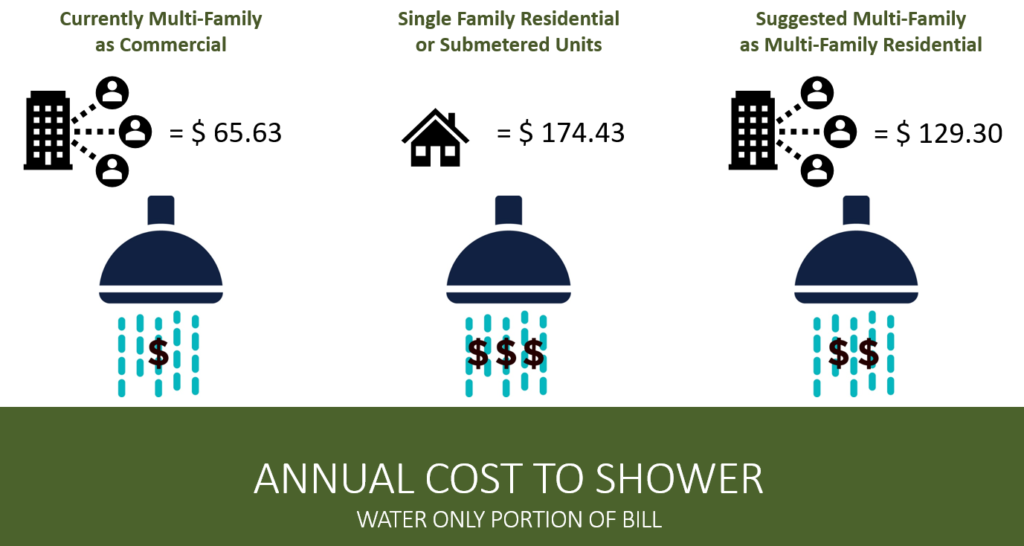
Apartment Customers: Each apartment management company spreads its utility costs to its residents differently, so the City of Georgetown likely won’t be able to explain how you were charged for Georgetown water services. If you have questions about your utility bill, please reach out to your property management company to understand how the company spreads the costs of the complex’s monthly utility bill to its residents. Read the letter the City sent apartment management companies about the changes in August 2022.
The new water and wastewater rates will go into effect Oct. 1, 2022. The adopted rates for Georgetown Water Utility make Georgetown’s cost of service the third lowest in the region for residential customers using 6,000 gallons a month or fewer. For residential customers using 10,000 gallons or more, Georgetown would remain the lowest cost in the region.
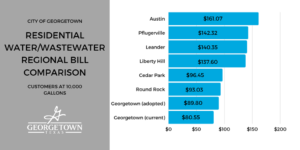
Base Water Rates
| Base water rates: Inside City Limits *Rates take effect Oct. 1, 2022 *Cost is per 1,000 gallons |
||
| Size | Current | Adopted |
| 5/8 inch meter | $16.50 | $18.40 |
| 3/4 inch meter | $24.50 | $27.30 |
| 1 inch meter | $41.00 | $45.70 |
| 1 1/2 inch meter | $81.45 | $90.80 |
| 2 inch meter | $163.40 | $182.20 |
| 3 inch meter | $391.75 | $436.80 |
| 4 inch meter | $685.55 | $764.40 |
| 6 inch meter | $1,501 | $1,673.60 |
| 8 inch meter | $2,608.10 | $2,908.05 |
| Base water rates: Outside City Limits *Rates take effect Oct. 1, 2022 *Cost is per 1,000 gallons |
||
| Size | Current | Adopted |
| 5/8 inch meter | $19.80 | $22.10 |
| 3/4 inch meter | $29.45 | $32.85 |
| 1 inch meter | $49.25 | $54.90 |
| 1 1/2 inch meter | $97.95 | $109.20 |
| 2 inch meter | $196.40 | $219.00 |
| 3 inch meter | $470.95 | $525.10 |
| 4 inch meter | $824.15 | $918.90 |
| 6 inch meter | $1,804.50 | $2,012.00 |
| 8 inch meter | $3,135.40 | $3,496.00 |
| Volumetric Charge *Rates take effect Oct. 1, 2022 |
||
| Gallons | Current | Adopted |
| 0-7,000 | $1.85 | $2.05 |
| 7,001-15,000 | $2.75 | $3.10 |
| 15,001-25,000 | $4.80 | $5.35 |
| 25,000 and more | $8.40 | $9.40 |
| Non-Residential Volumetric Water Rates *Rates take effect Oct. 1, 2022 *Cost is per 1,000 gallons |
||||||
| Customer Type | Meter Size | Current: Tier 1 Rate | Adopted: Tier 1 Rate | Current: Tier 2 Rate | Adopted: Tier 2 Rate | Tier 2 Threshold |
| Small Commercial | <2″ | $2.40 | $2.70 | $6.50 | $7.25 | 300,001 gallons |
| Large Commercial | 2″ | $2.40 | $2.70 | $6.50 | $7.25 | 600,001 gallons |
| Large Commercial | 3″ | $2.40 | $2.70 | $6.50 | $7.25 | 900,001 gallons |
| Large Commercial | 4″ | $2.40 | $2.70 | $6.50 | $7.25 | 4,000,001 gallons |
| Large Commercial | 6″ | $2.40 | $2.70 | $6.50 | $7.25 | 6,000,001 gallons |
| Large Commercial | 8″ | $2.40 | $2.70 | $6.50 | $7.25 | 8,000,001 gallons |
| Manufacturing | <8″ | $2.40 | $2.70 | |||
| Municipal Interruptible | $2.40 | $2.70 | ||||
| Restaurant | $2.40 | $2.70 | ||||
| Evaporative Cooling | $2.40 | $2.70 | ||||
| Fire Flow | $2.40 | $2.70 | ||||
| Irrigation Only | $4 | $4.45 | ||||
| Fire Hydrant Meter | $8.50 | $9.50 | $8.50 | $9.50 | 500,001 gallons | |
| Non-Potable Rates *Rates take effect Oct. 1, 2022 *Cost is per 1,000 gallons |
||
| Current | Adopted | |
| Reclaimed Water | $1.25 | $1.40 |
| Multifamily (Master Metered) Water Rates *Rates take effect Oct. 1, 2022 *Cost is per 1,000 gallons |
||
| Inside Adopted* | Outside Adopted* | |
| Base | $18.40 x Unit Count | $22.10 x Unit Count |
| Tier 1 Unit Count x 7,000 gallons | $2.05 | |
| Tier 2 Unit Count x 8,000 above Tier 1 | $3.10 | |
| Tier 3 Unit Count x 10,000 above Tier 2 | $5.35 | |
| Tier 4 all flows above Tier 3 | $9.40 | |
Wastewater Rates
| Wastewater Rates: Inside City limits *Rates take effect Oct. 1, 2022 *Cost is per 1,000 gallons |
||||
| Customer Type | Current: Base | Adopted*: Base | Current: Volumetric | Adopted*: Volumetric |
| Residential | $34.85 | $38.85 | ||
| Commercial | $52.70 | $58.75 | $3 | $3.35 |
| High Strength | $52.70 | N/A | $4.90 | N/A |
| Large Commercial | $93.60 | $104.35 | $3 | $3.35 |
| Industrial | N/A | $81.05 | N/A | $3.35 |
| Large Industrial | N/A | $126.65 | N/A | $3.35 |
| Multifamily | $125.20 | $25.90 x Unit Count | $3 | N/A |
| Wastewater Rates: Outside City limits *Rates take effect Oct. 1, 2022 *Cost is per 1,000 gallons |
||||
| Customer Type | Current: Base | Adopted*: Base | Current: Volumetric | Adopted*: Volumetric |
| Residential | $40.10 | $44.70 | ||
| Commercial | $60.65 | $67.60 | $3.45 | $3.85 |
| High Strength | $60.65 | N/A | $5.65 | N/A |
| Large Commercial | $107.65 | $120.05 | $3.45 | $3.85 |
| Industrial | N/A | $89.90 | N/A | $3.85 |
| Large Industrial | N/A | $142.30 | N/A | $3.85 |
| Multifamily | $143.95 | $160.50 | $3.45 | $3.85 |
*Residential low-income discount of 20% is available to customers who can provide us with verifiable proof of participation in the Medicaid Program by a permanent resident in the household.
- Click here for 2020 Water Rate Study information
- Jan. 1, 2021: Current rates went into effect
- Feb. 22, 2022: Initial water rate study findings presented to City Council. Coversheet | Presentation | Video (Item A)
- June 9, 2022: Updated water rate study findings presented to the Water Utility Board. Coversheet | Presentation.
Water Utility Board members asked staff to look at different ways to restructure the rates to accomplish two goals:
– Encourage (and reward) conservation
– Shield existing customers from growth, noting that some of this work will come from an impact fee study - June 28, 2022: Updated water rate study findings presented to City Council during the 2 p.m. Workshop. Coversheet | Presentation
- Aug. 23, 2022: Council approves first reading of new water rates. Agenda (Items AZ-BB) | Video (Items AZ-BB)
- Sept. 13, 2022: Council adopted new water and wastewater rates. Video (Items AG-AI) | Presentation (Items AH-AHI)
- Oct. 1, 2022: New rates are in effect.
Why is the City doing a water rate study?
As an industry best practice and according to the City’s Fiscal and Budgetary Policy, the City is required to conduct a rate study for its utilities every three years. The City’s last rate study was in 2020, which led to changes to residential water and wastewater rates effective January 2021.
The previous study primarily looked at customer classes and ensuring equity between the classes. This study considers increased operation and maintenance costs; resiliency projects required by Senate Bill 3; inflationary pressures; and increased costs with financing the maintenance to three plants that are approaching 30 years old and in desperate need of rehabilitation. These projects will diversify our water sources and add much needed resiliency to the treatment system that will benefit both existing and new customers.
Prior to the 2020 study, the most recent study was in 2018 and led to changes to commercial water rates and wastewater rates. Residential water rates were not changed. According to the 2018 study, the City’s water rates were forecasted to generate lower revenues than necessary to maintain the system in Fiscal Year 2021; however, because of increased peak demand and the acceleration of several capital improvement projects, the need for additional revenues came sooner than forecasted.
Accelerated capital improvement projects for the water utility include:
- North Lake Water Treatment Plant expansion: Construction to be completed in 2023.
- New South Lake Treatment Plant: Construction started May 2022; projected completion 2025-26
When finished, these projects combined are expected to more than double our current water treatment capacity.
What is included in a rate study?
A rate study reviews all the costs associated with operating, maintaining, and expanding a utility and projects those costs over a period of time to determine the revenue required to cover those costs. In addition to expenses, cost-of-service rate studies also evaluate how the different types of customers, such as residential, industrial, commercial users, use the system to make sure each type of rate payer is paying their fair share and treated equitably.
What is cost of service?
A cost of service reflects how the total water utility cost is spread or allocated to the customer classes based on their usage of the system. This cost-of-service method determines how to equitably allocate the revenue requirements among the various classes of service. The cost allocated to the customer classes is based on the utility’s revenue requirement. The revenue requirement is the level of income necessary for the operation and maintenance of the water utility and helps determine how much revenue needs to be recovered with water rates. Not all customers consume in the same manner or require the same facilities to be served, so a cost-of-service study answers what cost differences exist to serve the various customer classes of service. This helps in identifying rate setting to ensure all customer classes are paying their fair share based on the data.
How are rates determined?
The recommended rates come from the rate study and are specifically designed to cover the costs of the utility, address customer type equity, and any other policy goals of City Council, such as encouraging conservation. By law, rates may be set only to recover the cost of providing service. Once the rate study is concluded, rates are recommended to the Water Utility Board and City Council. The Water Utility Board recommends rates to the City Council, who approves new rates by City ordinance.
What does my water rate pay for?
The water and wastewater rates pay for the costs of operating the utility including personnel, maintenance, water resources, administration, debt service, and capital construction.
When was the last time water rates were adjusted?
Water rates were last adjusted for residential customers in 2021. Before that, it was 2014. Nonresidential water rates were changed in 2019. Sewer rates were updated for all customers in 2019.
How does growth pay for CIP projects/expansions?
Growth helps pay for system capital expansion through the collection of impact fees assessed to new residential or commercial buildings when new customers are connected to the system. These new customers also increase total monthly revenue to help with the fixed and variable costs of operating the utility
Does the utility receive and use tax dollars to pay for operations?
No. The cost of operating the water utility is paid by customers through rates. The water utility does use services from general fund departments such as human resources, finance, and IT. However, these services are paid for through a fund transfer to the general fund. The water utility also transfers a return on investment and franchise fee to the general fund. All those costs, whether direct or indirect costs of the utility, are included in rates paid by customers.
The most significant change to the rates in 2014 was the structural changes to the rates to ensure the fixed costs of the utility (those not determined by actual water usage) are properly collected in the base rate. A rate study implemented in 2018 resulted in the creation of tiered rates for non-residential customers and an increase in the flat-rate sewer charge to residential customers.
The rate study completed in 2020 was done a year early due to the anticipated need for additional revenue to help fund significant water and wastewater projects that have been accelerated to meet customer demand. The changes in water rates are the first in seven years, while the change in sewer rates comes only two years after the last change in 2019. The 2018 rate study predicted the sewer rate would need to be increased in 2020.
Contact
For questions about this process, please email pio@georgetown.org, and a member of our communications or water team will get back to you promptly.








